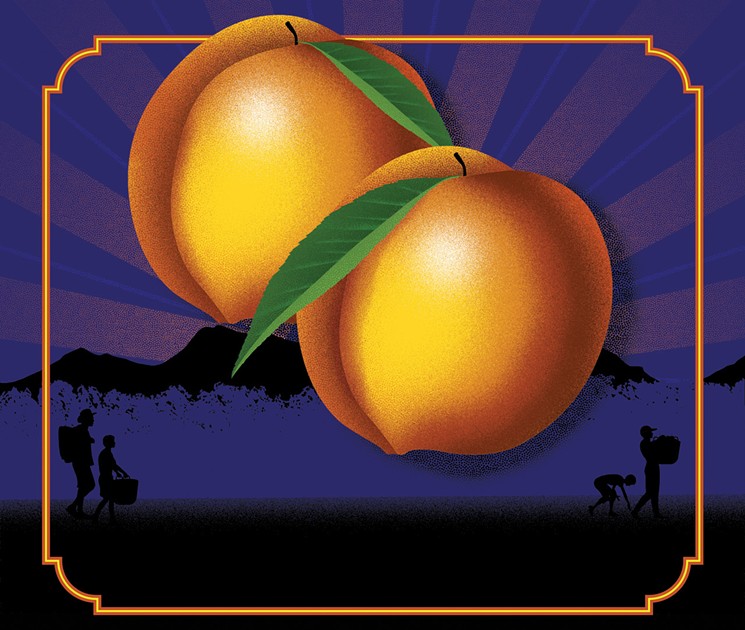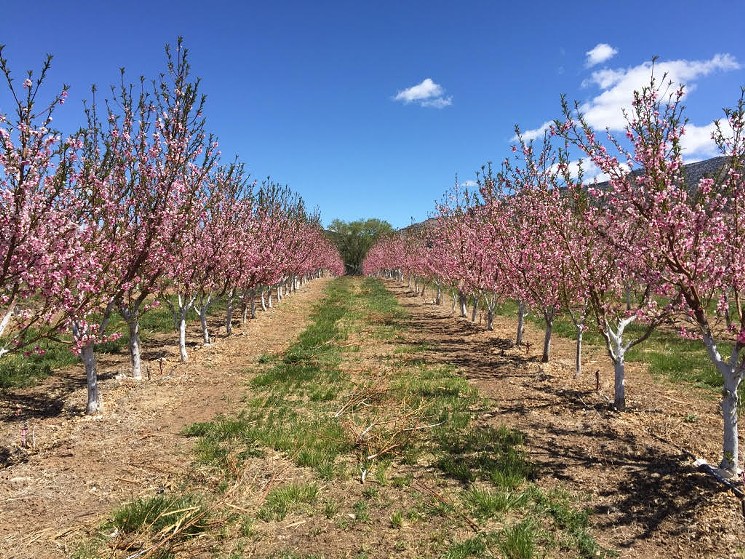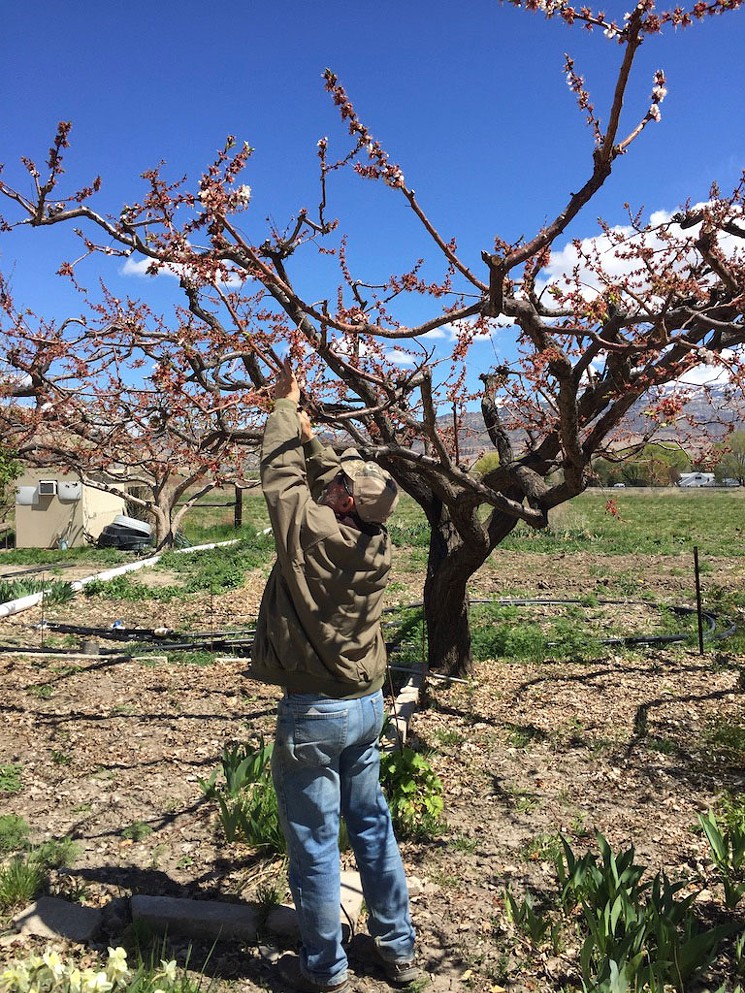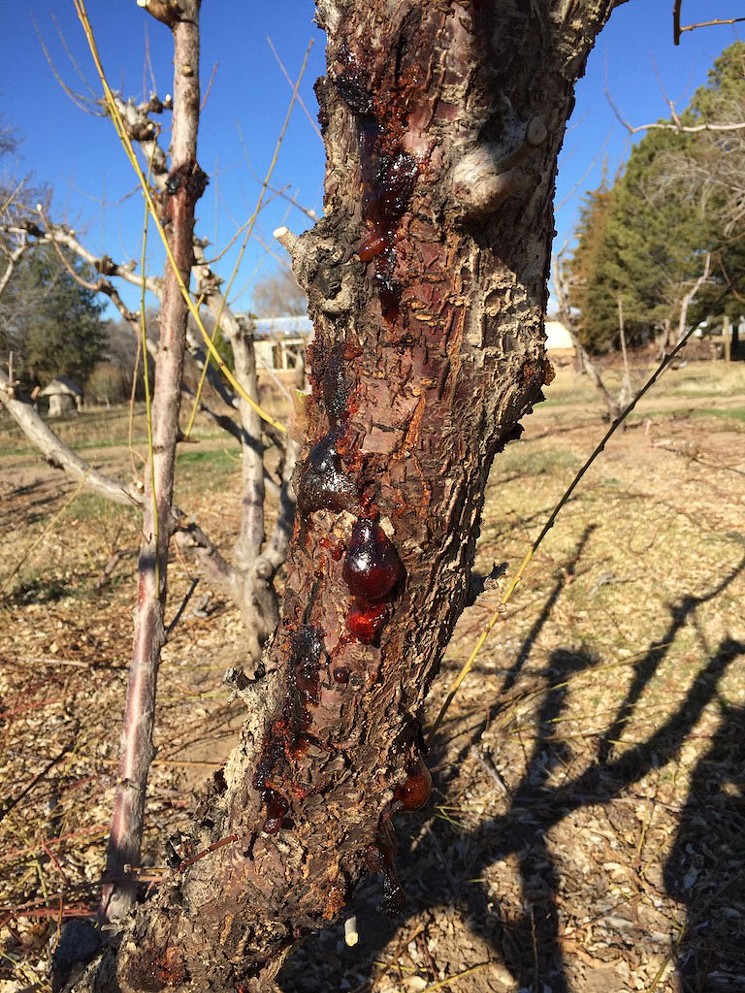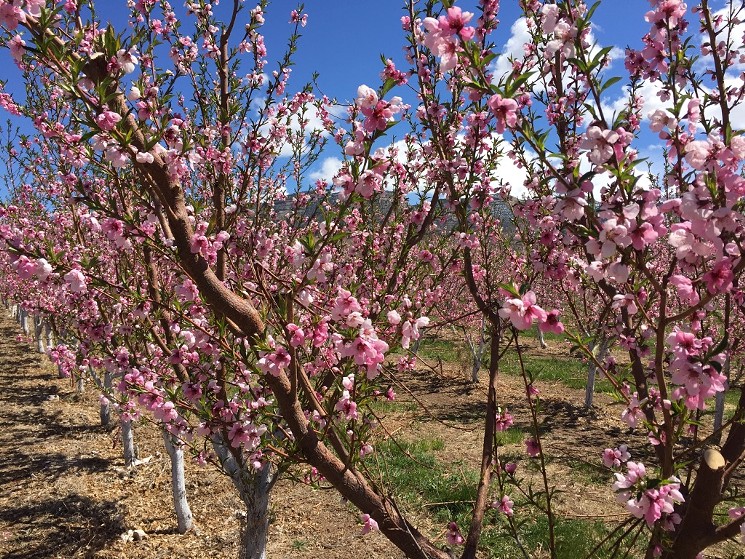West Word: The Peaches Are Local. The Pickers Are Not.
by Helen Thorpe | July 16, 2019
You know it’s full summer in the Rockies when boxes of field-packed fruit grown on the Western Slope are loaded onto trucks and driven up into the mountains, over the Continental Divide and down into the big cities that line the Front Range. First come the cherries, then the apricots, pears and, finally, the area’s famous peaches — extra-large, sunset rose, tangy sweet, astoundingly juicy. Apples also grow well on the Western Slope, but are found in greater quantity in areas to the north. It’s frost-sensitive peaches that really love the mild winters of the sheltered river valleys around Palisade, Paonia and Hotchkiss.
The peaches are so renowned that people around Denver form buying clubs to obtain them in bulk. For the past ten years or so, I have been getting boxes of fruit through a Community Supported Agriculture (CSA) group run by Monroe Organic Farms; lately the peaches have come from Rancho Durazno, Ela Family Farms and First Fruits, some of the top organic growers in the area. One August, I met a friend at the Denver Botanic Gardens right after getting a box of mid-season peaches and took along two fuzzy globes for a snack. I believe they were an heirloom variety called Suncrest, famous for its flavor. They were so gushy that we had to lean over to let the juice run off our chins. I had forgotten napkins, and we tried washing up in a fountain, but did so imperfectly. “My hands are stuck to the steering wheel,” the man texted afterward.
A bumper crop or a paltry one makes front-page news, and TV reporters rush to orchards with cameras if a troublesome fungus starts girdling trees. This year, there have been few frosts and plenty of rain. The Western Slope is poised to produce such a vast quantity of peaches that the big question facing growers — given the acute shortage of farm labor — is where will they find enough workers to pick all that bounty?
Bruce Talbott grows more peaches than anybody in Colorado, and over the past year, he let me visit his orchards periodically to better understand the work that takes place there. The Talbott family owns or manages about 150,000 fruit trees (and about as many grapevines) around the town of Palisade, population 2,692. If you travel there, you’ll see the Colorado River run through a fertile alluvial valley, entirely crisscrossed with orchards. Fruit trees grow in neat rows right up to the houses, sometimes in places where homeowners might have put lawns. On either side of town rise opposing walls of red-orange stone.
The valley serves as an auspicious place to grow fruit for several reasons: It’s very sunny, there’s ample water, and it’s tightly contained by those vertical stone walls. On one side towers 10,000-foot-tall Grand Mesa, and on the other stand the vertically striated buttes named Book Cliffs but called the Palisades in these parts, because the striped stone resembles the kind of fence you might see around a fort. All night long, what is known in Mesa County as “the million-dollar breeze” constantly slides down the canyon, shifting colder air that might want to settle on the valley floor farther away, past all the peaches. As a result, farmers in the area enjoy yields that are unusually abundant.
It was the middle of December when I first visited, and the orchards were bare — no fruit, no blossoms, no leaves, just gray branches. I found Bruce Talbott at work inside the offices of Talbott Farms, on the second floor of the company’s packinghouse. He wore a pair of mud-encrusted boots, Carhartt pants, an olive twill shirt and a camo baseball hat. The lobby of his office was strewn with copies of Concealed Carry magazine, and as we drove around in his white Dodge Ram pickup, Talbott mentioned that he was a skeptic about the idea of a human contribution to climate change. But he was also a staunch advocate of using seasonal laborers from Mexico and Honduras. In his peak busy periods, Talbott was unable to find enough Americans to work in his orchards — though he advertised for American workers first — and he said that he believed this country needed a proper guest-worker program if he and his neighbors were going to remain in business.
During the quiet winter months, Talbott relied on a skeleton crew of about a dozen workers who lived in the United States year-round. We headed to an orchard where several of them were working. The fruit trees had put forth new twigs, and on the peach trees, those twigs had a reddish tinge, which lent a soft warmth to the otherwise gray and tawny landscape. Talbott was focused on what all this new growth meant in terms of future tasks; a lot more interior wood had to be cut out before summer, in his estimation. “I tell the guys, ‘You should be able to stand at the end of a row and see clear down to the other end,’” he said. At that point, looking down a row of trees, I saw only a confusion of young wood.
But where were his guys, exactly? We scoured an orchard filled with peaches, but the workers were nowhere in sight. We headed toward an orchard of pears to see if we could find them there. The pears were on a new lease: As labor costs had risen beyond what some could pay, the Talbotts had been acquiring or leasing land once run by others. The family now operated a checkerboard of plots, strewn all over the valley. Bruce and his brothers had posted aerial photographs of the properties across a wall in their office so that they could track all the different plots and what they had planted where.
“Let’s see if we can hear the saws,” Talbott said as we stepped out of his truck. Sure enough, a snarling buzz came through the rows. As we walked toward the noise, Talbott reached out to snap off a branch that was growing vertically, parallel with a tree’s trunk. Removing vertical branches from the center of the tree created a bowl effect, letting more sunlight into the interior, so that fruit would ripen even inside the crown. “What we’re doing here, I want this tree as low as possible,” he said. “I need tonnage, but I need fruit size even more. And I need it to be where it’s cheap to pick. This orchard used to be three feet taller than it is. Over time, we’re bringing it down. And we’re opening it up; we’re trying to get light everywhere. And the other thing is, we have fire-blight symptoms here, so they’re cutting that out. You want healthy fruiting wood, right volume, easy to reach.”
We walked toward the growl of the saws until we saw a pair of guys wearing blue jeans, flannel shirts, work gloves and noise-reducing headphones. They were cutting out limbs that bore signs of blight — dead leaves that looked burned, alongside infant pears that had never matured. At a glance, Talbott realized that their saws were moving too slowly: The chains were dull. After chatting in Spanish with the workers, he ascertained that the sharpening stones on both saws had been worn away, picked up his cell phone and asked somebody to buy a chain-saw sharpener. Then he started snapping off more vertical branches. Talbott was a man of constant action, and could not give a tour of his orchards without doing a bit of work himself.
We found the rest of his small, year-round crew across the valley, digging holes to plant new trees. The field was already half planted, with baby peach trees that stood about to my waist. “For the first year, the trees are kind of wimpy,” Talbott said. “Second year, they start to take off. Third year, if they have fruit, that’s okay, I don’t care — I’m just happy they’re a tree. Fourth year, I want a crop.”
Later that day, back at the main office, I went to refill my coffee mug with the extra-strong brew the Talbotts kept on a burner by the sink. There I fell into conversation with Bruce’s brother Charlie, who did the company’s marketing. “So, what do you guys like to do in the winter?” I asked, making chitchat. “Do you get to go on a cruise? Or do you go to Las Vegas?”
“Gambling!” cried Charlie, looking aghast. “No. We don’t need to go to Las Vegas. We’ve got enough risk right around here.”
Charlie looked pointedly at Bruce as he spoke. He was referring to his brother’s big gamble to buy or lease all those non-contiguous plots of land, here and there across the valley, and plant more and more fruit trees. With every tree they planted, the Talbotts increased their potential yield — and also took on greater risk. Every tree was an investment, and also a form of exposure. They had no control over the weather and could not predict in advance exactly what price their fruit might fetch when it was picked. And the more trees they planted, the more laborers they required to get the crop out of the trees.
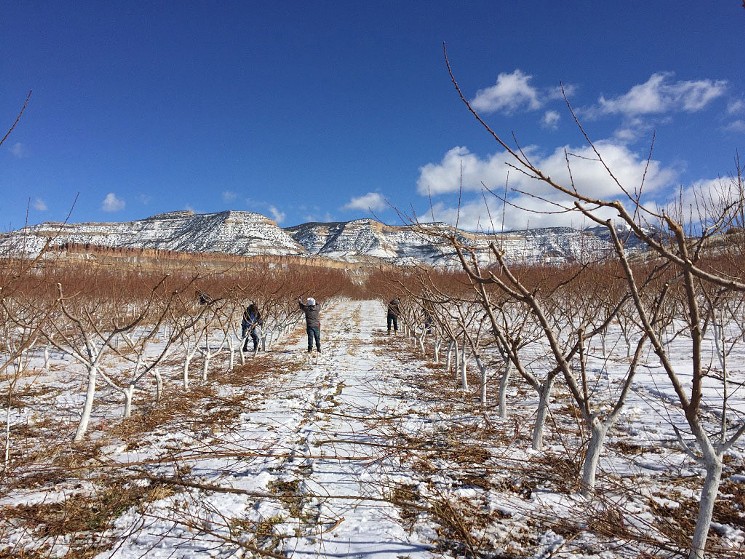
Helen Thorpe
Thirty-eight men from various parts of Mexico arrived to prune
all 150,000 of the Talbott trees starting in the middle of February. I
met them on a cold morning when the temperature had plunged into the
twenties and snow was coming down thick and heavy. Talbott had given the
crew the morning off because of the inclement weather.
“There’s the
human misery side of it, plus we don’t like to prune wet trees,” he
said. Wet trees were more susceptible to disease, which liked to enter a
tree through pruning cuts. In recent years a troublesome fungus called cytospora
had been making its way from orchard to orchard, shortening the lives
of peach trees, and he wanted to minimize its spread. I chatted with
some of the workers in my clumsy version of Spanish when they came to
the office to ask if they had gotten any mail. The men were reticent,
and I did not learn much about them except the parts of Mexico they were
from: Sonora, Guanajuato, Michoacán.
That afternoon, when the snow ceased tumbling down, I found the entire crew outside in an orchard of five-year-old trees, pruning a heavy-producing variety known as Rich Lady. Most of the crew members wore multiple layers of hoodies and flannel shirts; one or two possessed proper winter coats. They were far from home, it was cold, and there were 2,400 trees in this orchard alone. A young man from Sonora confided that it was his first time in the United States, and he did not know a soul on the work crew. When I told him that I was from Denver, he asked, “Where is that?” He wanted to visit the big city, and seemed crestfallen to hear it was on the other side of a very tall mountain range.
As the day turned sunny, the men shed layers, hanging hoodies and flannel shirts on the pruned trees, using them as coat stands. Each member of the crew carried three tools: small hand shears, long-handled loppers, and a handsaw for tackling bigger branches. Mostly they relied on the loppers. As they moved through the orchard, the only noise I could hear was the percussive sound of them snipping through limbs, along with some faint ranchera music. A team of brothers named Eladio and Oscar were listening to music while they worked, sending the sound of an upbeat accordion and a wistful tenor voice drifting through the trees.
Eladio taught me the Spanish words for the tools they carried and told me stories about his wife and their three small children. He would remain in the United States until the harvest ended in October, which meant that he would not see his family for the next eight months. Most of the men shared Eladio’s circumstances; they had left behind loved ones they would not see for most of the year. Their homesickness was palpable. If I asked about the difficulty of the separation, however, the men turned stoic. They were glad to have this job, they declared; they were outside, the sun was shining, and they were getting paid.
The number of trees looked insurmountable. But the men worked quickly, speedily transforming each mess of new shoots into a cleanly sculpted bowl. It took a pair of laborers between five and seven minutes to finish a single tree. Soon I could read the extent of their labor on the landscape, vivid red wood decorating the white snow wherever they had pruned. Eventually long shadows fell over the orchard, and the trees slipped into twilight. The foreman let out a long whistle, and the men started walking back down the rows toward their vehicles. “I want dinner!” one of them called out in Spanish. When I counted the rows, I discovered that in five hours, the 38 men had pruned 1,700 trees. I found the number so extraordinary that I counted twice.
When I reached the main office, everybody had gone home for the day, including Bruce Talbott. I sent him an email letting him know that I was leaving, and mentioned the phenomenal amount of work done by his crew. He wrote back, “We do have good people and without them we cease to exist.”
The issue for a grower like Bruce Talbott was that as soon as the
workers arrived, payroll expenses went through the roof. Because he was
using an H-2A crew,
Talbott had to pay all the transportation expenses for the 38 men who
had come from Mexico, plus two additional men from Honduras. To fetch
the men from Mexico, Talbott had hired a private bus to drive 1,327
miles south to Monterrey. Forty men had traveled to that city from their
various home states, staying in hotels at Talbott’s expense while they
tried to pass muster at the U.S. Consulate. Two were red-flagged after
their names turned up in a database of individuals who had been
apprehended while trying to cross the border. Thirty-eight succeeded in
obtaining coveted visas and boarded the rented bus for the drive north
to Palisade; Talbott paid to fly the two men from Honduras to Grand
Junction.
Once the team arrived, Talbott was also required to
provide free housing. The men were living in modular units built beside
the orchards they were pruning. This crew would handle all the major
spring tasks: taking 60 to 70 percent of the wood off each tree,
planting tens of thousands of new trees, getting irrigation systems
working, and reducing crop loads until each tree held just the right
amount of peaches.
Talbott had used the H-2A program for the better part of eleven years, and this was the only time he could recall when a crew had shown up on schedule. Other growers in the valley were fuming because their crews had yet to appear. Talbott hoped to get an additional forty H-2A workers to help get ripe fruit out of the trees during harvest. The previous summer, however, Talbott’s H-2A laborers had failed to arrive when he needed them most. He had published a scorching op-ed in the Washington Post about the problem under the headline, “Our fruit is rotting in the trees as laborers are kept out of the country.”
“For the past few months, our farm’s 57 field workers have been scrambling to pick 4,000 tons of peaches before they’re too ripe to ship across the Midwest,” wrote Talbott. “They’ve routinely put in 12-hour shifts and didn’t get a single day off for seven weeks straight. It’s harvest season, when peaches must be picked in a short window of time. But over the century our farm has been in business, this year has been especially grueling. We’ve been so shorthanded that we lost 40,000 pounds of peaches because we couldn’t pick them fast enough.” One of Talbott’s neighbors, Dennis Clark of Clark Family Orchards, said that he “almost had a stroke” last summer waiting for H-2A workers who did not show up when his fruit needed to be picked.
Talbott had learned what this year’s H-2A wage rate would be at a gathering of local fruit and vegetable growers, the Colorado Fruit & Vegetable Growers Association, during the winter months at the Adams County Fairgrounds. I found the growers assembled in the main hall, underneath an immense American flag that hung right over a booth manned by representatives of MAS Labor, an outfit that recruited H-2A laborers from foreign countries. Jason Resnick, a lawyer from the Western Growers Association, spoke of the demographic forces that had caused the farming workforce to contract: “It’s kind of hard to pin down the number of farm workers living in the United States exactly, but it is probably anywhere from 1.1 to 1.4 million.” Two decades prior, the United States had ten times as many domestic farmworkers, but millions of people who had once traveled seasonally to pick fruit and vegetables had instead “settled out” and stopped moving around, opting to remain closer to their families. Instead of doing farm work, they had taken jobs in construction, landscaping, oil or restaurants. Their children had opted for other work, too, and had not replaced their parents in the fields and orchards. Nor were many replacements showing up from Mexico, because the birth rate in that country had declined, and it had gotten more dangerous and more expensive to cross the border illegally. Consequently, the number of farmworkers left in the United States had plummeted, and the remaining cohort had aged significantly; 15 percent of the workforce was presently older than 55. “I get calls from members saying, ‘Hey, Jason, we have a worker who has been with us since he was 21 years old,’” Resnick told the crowd. “‘He’s now 75 and he’s wanting to drive a tractor. What do we do?’”
Most of the 1.4 million or so aging farmworkers left in this country were immigrants who had been living in the United States for decades without legal status. This left employers vulnerable if ICE conducted an audit: An ICE raid could sweep up undocumented workers just as they were needed for harvest, leaving growers without anybody to do the critical work on which their entire income depended. The only two alternative solutions available to the growers gathered in this hall were mechanization or H-2A labor. During a break in the talks, growers wandered from booth to booth listening to sales pitches about various mechanical solutions to their labor issues. None of the machines were cheap, and many were better suited to crops other than the ones they grew. A salesman for Checchi e Magli, an Italian company, touted a transplanter that could ferry a row of seated workers through a field, allowing them to drop plugs of seedlings such as lettuce or tomatoes down into a chute, whereupon the machine would force the plug swiftly into the ground, avoiding the time-consuming labor of planting by hand.
“We can do about 5,000 plants an hour,” he said. “The limiting factor is the American-sized butt.”
“How does it work in mud?” asked a melon grower from Rocky Ford.
“Mud?” echoed the salesman. “Oh, it doesn’t work in mud.”
After the break, the growers reassembled to hear more about the H-2A visa program. Over the past twenty years, the use of H-2A labor had grown from almost nothing to over 140,000 workers per year. Fruit growers used the program frequently because of the hand labor involved in tending their trees. A grower named Eric Hanagan took the stage to regale the audience with his experiences using the H-2A program. Hanagan grew tomatoes, cucumbers, squash, onions, beets, sweet corn, okra, chiles, pumpkins and melons on a 150-acre farm near Swink, down in the Arkansas River Valley in the southeastern corner of the state. He had wanted to use American labor but could not find workers who could handle the tasks. “We hold our interviews at 6:30 a.m., because that’s when our work day begins,” he told the crowd. “We don’t get any Americans.”
But the H-2A program was expensive. Growers had to pay what was known as an “adverse wage” — a rate set by the federal government deliberately above the market rate — to protect American workers’ wages from being undercut by foreign labor. “The mountain region, which includes Colorado, Utah and Nevada, is going to see the biggest increase in H-2A wages of any region of the country this year,” Resnick announced, to audible groans. “Adverse wage is going to go up from $10.69 to $13.13 an hour in January. That’s up 23 percent.”
The Adams County gathering was chaired by Robert Sakata, a Japanese-American grower based in Brighton. His grandparents had been interned during World War II and had lost everything they owned in the process; they’d later worked their way back to prosperity by becoming the region’s largest supplier of sweet corn. Sakata sweet corn had been a staple along the Front Range for fifty years. The previous March, however, Robert Sakata had announced that he could no longer afford to grow sweet corn, so impossible had it become to find American workers to pick the corn by hand, and so costly was it to import part-time workers from Mexico through the H-2A program. That decision made front-page news in Denver. Now the dramatic hike in the adverse wage caused other fruit and vegetable growers throughout the region to wonder if they, too, needed to simply stop growing food locally. Some berry and lettuce growers have moved their operations to Mexico, as they can no longer get enough laborers to come here. But that wasn’t an option for peach growers, who have invested hundreds of thousands of dollars in trees they cannot relocate.
Not long after the meeting, as news of the wage increases filtered through the American agricultural industry, growers banded together to sue the federal government over the concept of the adverse wage. They felt the idea had been dreamed up in Washington, by people with no sense of the present reality in the American heartland. “Our argument is, show us an American who’s losing a job,” Talbott said. “They are not there.” A judge dismissed the growers’ request for a temporary injunction that would have halted the wage increase, and the growers responded by filing an appeal.
Talbott fretted all spring about the impact of pay for his H-2A workers jumping from $10.69 to $13.13 an hour. Because his American workers mixed with the H-2A crew and did the same type of work, he had to provide the same wage increase to the dozen “corresponding workers” already on his payroll; previously, he’d paid the American workers $11 an hour. All told, the 23 percent spike in the wage rate would result in an extra quarter of a million dollars in labor costs. “That’s my margin,” Talbott said bluntly, strain and frustration evident in his voice. Because the adverse wage had gone up so much, Talbott was no longer sure whether he would earn a single penny in profit over the coming year.
Spring arrives on the Western Slope in the form of a frantic race against time. Days get longer, temperatures rise, and trees awaken from their winter slumber. Work crews hurry to finish pruning so that they can begin all the other tasks that must be done before the trees bear fruit. On a sunny morning in March, I found the H-2A work crew in an orchard of twelve-year-old trees, winding up the last week of pruning. They slung silver ladders up against the trees, ran up the rungs, and pruned from the top down. This orchard held a variety called Zee Lady, prized by Talbott because the fruit ripened at a point in summer when none of his other peaches did. Zee Lady was an essential part of his mix, bringing Talbott income when he had nothing else to sell.
Yet as I walked around the orchard, I saw that bark had blackened and burst, exposing inner layers of wood, and the trees were weeping huge globules of amber sap. This was the work of the tree-killing cytospora. Talbott would have to take the orchard out soon, but because he had nothing else to sell when Zee Lady ripened, he had kept the diseased orchard going for one more year. The H-2A wage hike meant he could not afford to lose trees at the rate that the fungus wanted to decimate them.
Cytospora bedevils peach growers by shortening the lifespan of their trees, especially those grown in places that see big swings in temperature, such as western Colorado, and Palisade orchards have been hit harder than anywhere else. Last summer, TV crews invaded orchards to capture images of the fungus, then blared talk of the possible demise of the local peach across the evening news. Dennis Clark got a worried phone call from his fruit broker, who feared that he could not sell his peaches anymore. Clark had to explain that a fungus affects only a tree’s wood, not its fruit. Now the growers remained fearful that ignorance combined with bad press could cause a dip in their sales just when they could least afford it. When high labor costs had already eroded profit margins, the last thing they needed was a public-relations disaster.
The fungus was not new, but its virulence in recent years had taken growers by surprise. Tree pathologist Jane Stewart of Colorado State University had told a standing-room-only crowd at the winter meeting of the Western Colorado Horticultural Society in Grand Junction that the fungus was found across the country, but no other orchards had seen an outbreak like the one affecting the Western Slope. Her testing showed the fungus had afflicted 100 percent of the region’s orchards. The big puzzle concerned how the fungus spread from one orchard to the next. Stewart displayed a map indicating that it was leaping over healthy trees to attack those in far-off locations, even though a fungus should not be able to hop around like that. Typically, a fungus will only jump to an adjacent tree via rain splash. How was cytospora moving about so easily? Could it be spread via pruning shears? When Stewart asked growers for their thoughts, Talbott said that in his orchards, it looked as though wind might be a factor. Could a wind-borne insect transport the fungus? Stewart got excited about this theory and pledged to test for wind-borne insects carrying cytospora by putting up Vaseline-covered Saran wrap traps in the area’s orchards.
Given the colliding challenges they faced, a French viticulturist asked the room full of weathered, baseball cap-wearing growers how they got out of bed in the morning.
“Fear of failure,” one answered dryly. “Fear of starving in the fall.”
And the room broke into laughter, because that was what they feared most.
Talbotts had been growing peaches in Palisade for five generations. Clarks had been growing peaches there for six generations. Their families had been neighbors and rivals for as long as anybody could recall. Dennis Clark remembers when Bruce Talbott and his brothers used stilts to pick their peaches, and Bruce remembers when Dennis and his brothers picked their peaches from the back of a mule-drawn platform. That’s why the peach growers were so upset about the difficulty they were having getting workers for harvest, and the challenge of paying for them. Tradition itself was at stake: All that history, all the effort that had gone into every peach crop over the last century.
On the cusp of spring, growers watch the weather intently. A hard freeze can render buds unviable. When the temperature drops too low, an alarm goes off in Bruce Talbott’s house, waking him in the middle of the night to oversee attempts to raise the temperature in the orchards by turning on wind machines. The tall structures — they look like windmills, but operate by the inverse principal, generating wind instead of harvesting it — dot the low-lying orchards that tend to get cold. Peach trees require a certain number of “chilling hours” each year, but once they have been cold for long enough, they can easily be woken out of dormancy — and then become more vulnerable to frost. This past winter, however, the temperatures in Palisade remained mild even when a news-making epic polar vortex settled over the northern part of the United States, and Talbott did not turn his wind machines on until one chilly weekend in April.
The following morning, I joined him as he went to see if he had sustained frost damage. We drove to a spot near the railroad tracks, which stood on raised ground. The tracks acted like a dam, creating a lake of cold air that liked to settle nearby. Talbott found an apricot tree — apricots are the most sensitive of the stone fruit — and sliced open its buds. They were all green, which meant they had sustained no damage. If the buds had frozen, they would have turned black on the inside. “The apricot is the canary in the coal mine,” he said. “If it’s fine, then I don’t worry about my other trees.”
His peach trees were in flower, and the entire valley had turned into a sea of pink-and-white blossoms. Certain varieties, like Summer Amelia and Bounty, had especially showy blooms that lit up entire hillsides. I caught up with the H-2A crew members in the middle of doing blossom reduction, which involved going back through every single orchard they had already pruned and running their hands along the twigs that were now filled with ten to twenty blooms; they had to reduce these to six flowers. Later, they would reduce the crop load further, choosing the best two or three peaches to keep, ensuring that the trees would produce extra-large and fine-tasting peaches. The orchard where the men were working contained a variety called Cresthaven, which had flowers that were a darker shade of pink, but on the dainty side. You had to get up close to appreciate their loveliness. Every row where the men had worked was carpeted with fallen blossoms.
Paonia and Hotchkiss stand at higher elevations than Palisade, and growers over there consequently had more nights when they had to run wind machines, light propane heaters or burn wood in metal bins to save their peaches. Because I get organic fruit from First Fruits, among other places, I went to see them on that same trip, and found owner Kris Kropp bleary-eyed from being up all night, surveying the propane heaters keeping his peaches alive. Steve Ela of Ela Family Farms had endured a few sleepless nights, as well. And when I stopped by Topp Fruits to see Harrison Topp, a young farmer who also works for the Rocky Mountain Farmers Union, I caught him at a dead sprint, running from one side of his property to the other, because it was the busiest time of the year and he could not afford H-2A workers.
Over in Palisade, however, that was the only really cold night. While everybody expected another frost or two, the weather just stayed mild. Then it began to rain and rain. By May, Talbott had made it beyond the point where his fruit was likely to freeze, and he could see that he might have a bumper crop. After working around the clock for months, he celebrated by taking a vacation to Florida.
Then it was time to get ready for summer. Blooms turned into small peaches, then bigger peaches. Growth of the fruit slowed during what is called the “stone-hardening phase,” as peach pits formed inside, and then the fruit went through “final swell.” In the middle of July, one variety after another will start ripening in successive waves — first Redhaven, then Rich Lady, Blazing Star, June Pride, Suncrest, Bounty, Zee Lady and so on. This will continue straight through until October. Talbott was expecting his second H-2A crew — another forty men — to arrive in mid-July, just in time to help with the immense task of picking 150,000 trees’ worth of fruit. All eighty of the seasonal workers plus the dozen members of the year-round crew will fan out into those orchards where peaches have ripened fully, wearing canvas bags hung by a strap around their necks. After filling a bag, each worker will walk over to a truck parked nearby and empty the bag by unclipping the bottom section, folded double to hold in the fruit, allowing the peaches to roll slowly out, and then he will turn around and pick some more. The crews will put in twelve-hour days, seven days a week, working constantly until every tree has been picked clean. Harvesting the entire crop will take about three months.
Martin Valdez Gonzalez is a labor specialist who works with Colorado’s seasonal farmworker program, and he is a passionate defender of workers’ rights. I met him at one of this year’s many conferences about the farm labor crisis, and spoke with him later about the abuses that some H-2A laborers encounter while in the United States. Common complaints investigated by the state’s program include workers being bullied or living in substandard housing. Sometimes a grower asks workers to do tasks that are outside the scope of their contracts. But the most frequent complaint that labor specialists hear concerns what happens when a grower is pressed too hard by the brutal combination of rising costs and marginal returns, and fails to issue the checks that his workers have been expecting. This year, the complaints are likely to be fewer, as conditions are optimal.
One day, before the men got so busy they could not even pause to talk, I had a chance to speak at length with Raul, one of the men from Honduras who was employed by the Talbotts. Raul has worked in American orchards for the past nineteen years. He has three children, who are now mostly grown, and Raul was putting his two older daughters through college with his earnings. One daughter was halfway through law school, and another had just begun nursing school. I asked if it was hard to be away from them for so long, but he shrugged off my concern. He was helping his daughters secure their future, he said, and that was worth the sacrifice.
I had witnessed what long days the crews worked and how much labor was required to grow the fruit I had once taken for granted. But speaking with Raul forever changed the way I thought about the peaches I enjoy each summer. If you buy local fruit, you are supporting the families who live on the Western Slope and work so hard to grow food for the rest of us — the Talbotts, the Clarks, the Elas, the Kropps. But you also contribute to the education of Raul’s daughters and the well-being of each H-2A crew member’s children. Buying local fruit means building a better Western Slope, a stronger Central America and a more vibrant Mexico, all at the same time. I had not been able to see this on the Front Range, but it became obvious over in Palisade. Wall or no wall, there is no such thing as a hermetically sealed United States — as any conservative-minded, God-fearing, gun-carrying fruit grower can tell you, if you stop by his orchard to talk.
Helen Thorpe is the author of three books: Just Like Us, Soldier Girls and The Newcomers; learn more at helenthorpe.com. Comment on this story below, or email editorial@westword.com.
